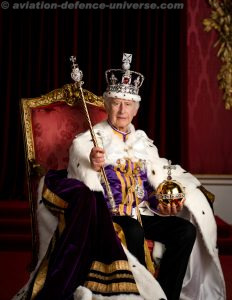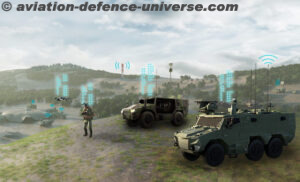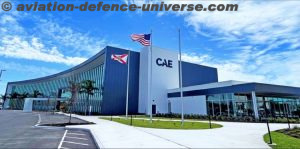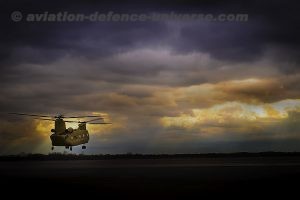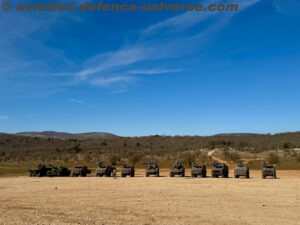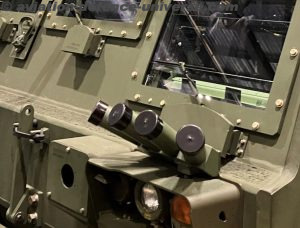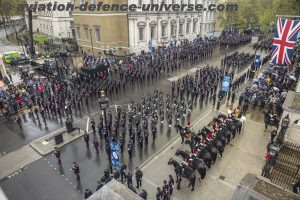
London. 06 May 2023. From Northallerton to the Isle of Mull, Belfast to Birmingham, soldiers of the British Army are gathering in training areas south of London to prepare for the biggest ceremonial event of their lives, the Coronation of Their Majesties The King and The Queen Consort on May 6th. Every element of the armed forces will be represented, and this is teamwork in action.
Soldiers have flown home from operational duties or training exercises from as far afield as Cyprus, Iraq, Kenya and Estonia to represent their regiments and corps and do their duty for King and country. Within hours of arrival back in the UK, they were preparing uniforms, swords and boots, and brushing up on their drill, before hitting the parade square for the first rehearsals for the Coronation Procession.
When His Majesty, coronated, travels back from Westminster Abbey to Buckingham Palace, he will be at the heart of the largest military procession in London for 70 years. Moving more than 6,000 troops seemingly effortlessly around the streets of London is never going to be easy, but the organisers for the tri-service Coronation procession, the British Army’s Household Division, have left no stone unturned. Every detail has been considered and tested before the plan was briefed to the units taking part, just three days ago.
For almost two weeks, soldiers whose normal specialism is logistics, engineering, communications, intelligence, administration, medical services, aeronautics or heavy armour, have been put out of their comfort zone, perfecting basic ceremonial drill moves in the privacy of their home bases around the UK. Now they have to take it up several notches!
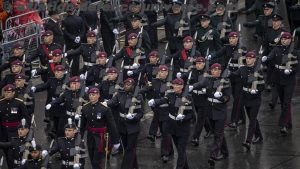
On Friday, in the grounds of the Royal Military Academy Sandhurst, they joined their infantry colleagues for the first time to put those moves into practise. Around 2,500 soldiers stepped off along a carefully measured and marked out practise parade route that replicated the distance and sharp turns of central London streets.
At the same time, ten miles away in Aldershot, more than seven hundred Guardsmen, Household Cavalry Troopers and Musicians came together for the first time with the Royal Company of Archers and Sovereign’s Bodyguard to rehearse down Queen’s Avenue, an excellent double for The Mall in Westminster.
Led by the Massed Bands of the Household Division and their Senior Officers, the Foot Guards marching 12 to 15 ranks wide with street liners either side were a sight to behold. No less impressive were the dismounted elements of the Blues and Royals and Life Guards of the Household Cavalry following on just behind them. Surprisingly, for some of those on parade, this was their first rehearsal as they have come straight from their operational role to take part.
Inkerman Company The 1st Battalion Grenadier Guards has recently returned from Operation SHADER in Iraq where they have been providing Force Protection in the region as well as training and mentoring to the Iraqi Army to prevent the rise of terrorist insurgency.
Prior to their processional practice, 40 of these Grenadier Guardsmen were awarded their Operation SHADER medal by Major General Chris Ghika, General Officer Commanding the Household Division, and these medals, for many young soldiers the first of their careers, will be worn proudly on the ceremonial events to come as a signifier of their dual role excellence.
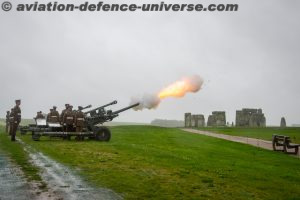
One of them, Guardsman Oliver Agathocleous, 20, from Chard in Somerset, who took part in the marching detachment on the funeral for Her Late Majesty The Queen’s funeral, will be a street liner for the Coronation Processions. He said: “It’s a great honour to be part of something as big as the Coronation. I came back from my first operational tour to Iraq in February, then went out on a big two-month infantry training exercise in Kenya, and now this is our focus.”
Like Oliver, The 1st Battalion Scots Guards and the 1st Battalion Coldstream Guards joined the procession training just hours after returning from Exercise ASKARI STORM in Kenya where they have been practising their Infantry skills and drills on the dry Kenyan Savannah.
Soldiers and Officers from the 1st Battalion Irish Guards taking part have also just briefly stepped back from operational duties. They have come from the large multinational team engaged in training the Ukrainian Armed Forces in bases across the UK, preparing them to defend their homeland from invasion.
Finally, several members of the Household Cavalry Regiment taking part recently flew back from UN Peacekeeping duties on Operation TOSCA in Cyprus and will be returning to operational duties immediately following the Coronation.
Over at the Royal Military Academy Sandhurst, 1,546 soldiers from more than 40 Armoured and Infantry units taking part in the Coronation have gathered at the historic site with 604 soldiers from 39 Commonwealth countries.
They are being accompanied by the massed bands of the British Army, who are using special ‘click track’ or electronic metronome for the first time to ensure that the drums are all beating at the same time along the length of the procession.
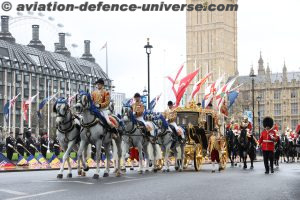
Captain Iain Forat, Officer Commanding the Army School Ceremonial, who has designed the mission specific drill training for the rehearsals, said: “To get so many on parade with being so busy as we are as an Armed Forces is absolutely brilliant. The parade is arduous, and the training is arduous to get to the standard that we need to deliver the parade.”
The plan for the logistics of the Coronation, sustaining the thousands of participants drawn from the UK and around the world, is the responsibility of Brigadier Patch Reehal, Commander 101 Operational Sustainment Brigade.
He said: “My team and I had the honour of performing this same role for the funeral of HRH The Duke of Edinburgh, Her Majesty The Queen’s Platinum Jubilee and most recently HM’s funeral. To now have been invited to play a part in the Coronation of our Sovereign and our Commander-in-Chief, is both a professional privilege and a moment of deep, personal, pride.
“The logistic plan is on a scale not seen since the State funeral of Sir Winston Churchill in 1965. My prime responsibilities are two-fold. First, to establish and operate the multiple Concentration Areas where United Kingdom Armed Forces, and those from Commonwealth and Realm Forces across the globe, are based and conduct their training.
“A snapshot of an average day will see the movement of 5,000 personnel, serving over 30,000 meals, 300 haircuts and drivers, tailors and catering staff working around the clock. Second, on the day of the Coronation, the large-scale movement of these forces to London and back.”
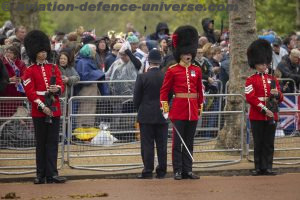
Lieutenant Sophie Hare, of The Light Dragoons, has just returned from exercises in Kenya and will march with her sword drawn at the front of her processional group before deploying to Estonia. Lt Hare said: “It’s a privilege to be involved in the Coronation. I will be thinking of our regimental forebears and current regimental family and striving to meet our regimental motto: ‘Merebimur’ (We shall be worthy).”
Thankfully, for the soldiers of the seven regiments of the Household Division, the Foot Guards and the Cavalry, ceremonial is built into their DNA. This was most acutely witnessed at the funeral of The Late Queen when soldiers from The King’s Company Grenadier Guards flew straight back from operations in Iraq to bear Her Majesty’s coffin and did so with such perfection and reverence despite the very short timelines.
Major James Hoy, the Number 2 Company Commander Grenadier Guards said: “The flip side of being good at drill is everyone expects the Guards to be excellent at all times, and that really adds to the pressure!”
Over the last seven months Garrison Sergeant Major Warrant Officer Class One Andrew ‘Vern’ Stokes, 51, from Ironbridge in Shropshire, has been at the heart of the planning team to deliver the ceremonial aspect of the Coronation. On Coronation Day he will be located at the side of the Gold State Coach and has the key role of stepping off the procession from his position in Parliament Square. “It’s a big event, large scale, and probably the biggest ceremonial event we have seen since 1953” he said. Last weekend he was running the London Marathon, and he claims that it was the intensity and solitary nature of the training for that race that gave him the headspace and clarity to solve some of the challenges posed by this gargantuan parade.
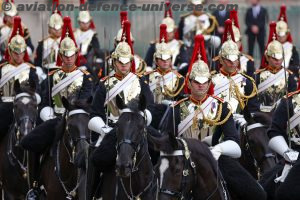
The marching pace for the procession is set at an unnatural 108 paces a minute which is slightly slower than a standard quick march of 116 paces a minute. So even for the ceremonial experts, the Guards in the Household Division, the Coronation Procession is a technical challenge. That pace is set by the Gold State Coach. It’s four tonnes, slow moving, which means that everything has to be timed from the rear of the procession. But Vern claims that the advantage of this is that this slightly altered pace will keep the whole parade tighter and more compact.
“The biggest challenge is that you have so many regiments represented from the Gurkhas to the Lancers, the Royal Navy to the RAF, and each has its own methods of doing drill with different pacing and so on. We’ve got to create a parade where everyone marches to the same pace, so the timings remain spot on.”
The pace is set with the bass drum and the marches chosen to be played by the Bands throughout the procession all have this regular 108 pace beat. He has designed a method of uniting all 19 processional bands to strike up at the same time and maintain the constant beat, whilst playing the same bar, with bands separated by distance over a procession group length of more than a mile. This has enabled a much larger scale of Service Personnel on the Coronation parade’s relatively short journey, by compressing the groups, which will make it so much more impressive.
He has also designed a unique drill manoeuvre to reduce the width of the marching groups from a twelve abreast frontage to six abreast, to enable the whole procession, which will have filled the entire width of The Mall, to filter elegantly through the Gates of Buckingham Palace.
“It’s a unique drill move and hugely complex,” he explained. “It involves some troops doing a swift wheel and marching backwards while others mark time for eight paces, simultaneously, so we reduce our flanks to six without increasing the distance, and that’s important because what we don’t want to do is slow the Gold State Coach down.”
There’s a lot of pressure resting on very young shoulders in the parade to get every detail right on the day, especially with one of the biggest ever global TV audiences expected to tune in.
Brigade Major Lieutenant Colonel James Shaw has the honour of leading the Coronation Procession from Westminster Abbey to Buckingham Palace. He will be mounted on a horse, Sovereign’s Shadow, at the very front of the procession approx. 1,500m in front of the Gold State Coach.
He said: “The Army has been supporting Coronations for a thousand years in this country, so we’ve got plenty of precedence. We’re part of that history, it’s very exciting. His Majesty The King is our Colonel-in-Chief, we have a very strong bond – it’s going to be very special for all on parade, and I’m confident we can get it right.”
Without doubt the Coronation is one of the greatest honours of Lieutenant Colonel Shaw’s life on top of leading the planning for Her Late Majesty Queen Elizabeth II’s Funeral and the Platinum Jubilee. His Grandfather (Colonel Freddie Shaw) marched on the Coronation in 1953. It’s that continuity of service to Sovereigns through the centuries that makes the Household Division’s role in the Coronation event so personal and enduring.
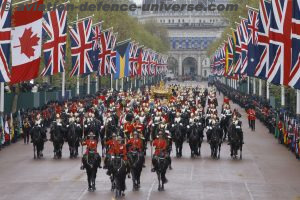
Lieutenant Lachlan de Klee, 27, from the Isle of Mull, who has just flown back after completing operational training in Kenya, will be carrying the King’s Colour at the head of the Coldstream Guards’ marching detachment on the procession in front of King Charles III. His maternal ancestor, John Leslie, carried the Sword of State at the Coronation of Charles II in 1660.
More recently, his grandfather who after an impressive career with the Scots Guards through WW2, founded G Squadron SAS, was on the Coronation of the Late Queen in 1953, and his great grandfather, who was Silver Stick in Waiting to Edward VIII, and at the Coronation of King George VI in 1937.
“Carrying the King’s Colour is the greatest honour, it’s the beating heart of the regiment,” he said. “But it’s very heavy and I’ve had to do a lot of working out in the gym to be up to the job! It’s a huge responsibility but an even bigger privilege. I was looking around during the rehearsal today and it’s the most people I’ve ever seen on parade from all the Foot Guards, certainly bigger than anything in our living memories, the scale is going to be magnificent.”
“From the moment we landed back in the UK we were straight into barracks and straight into tunic fittings in the Tailors,” explained Lachlan. “We’re all soldiers, but that dual role just adds to everything we do – one minute we’re out training for operations in the field in green kit, and the next on the biggest parade in modern history in red tunics, putting on the best show Britain has seen in 70 years, it doesn’t get better than that!”
At dawn on Tuesday morning, Lieutenant Colonel Roly Spiller, from Newmarket, was hosting the ANZAC Day service for the Multinational Force in the UN Buffer Zone in Cyprus. At one minute past midnight he was back in the UK sorting out his uniform and selecting his troopers for the processional rehearsals.
He said: “I’m acutely aware that generations of cavalry officers and soldiers will be watching us on the day and expecting nothing short of perfection. Making it all look effortless is extremely hard work.”
Garrison Sergeant Major Vern Stokes said: “When the Armed Forces are on parade they are representing the standards that are expected of those soldiers, by the nation they serve, and those standards link to what soldiers do on operations as well, that attention to detail, the ability to react, regardless of the situation, all of those skills are transferable from operations to ceremonial activity, so that’s a great start point for me, as one of the people organising it, knowing that all these people are capable and adaptable to anything.”
The latter troops provided protection for UK personnel deployed to the Middle East and were presented with their service medals before a rehearsal for the Coronation Procession at Aldershot on 28 April.
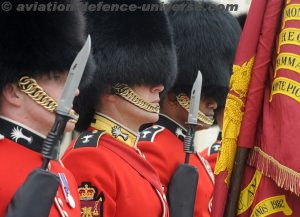
One of these soldiers, Guardsman Oliver Agathocleous, 20, from Chard in Somerset, who took part in the marching detachment for Her Late Majesty The Queen’s funeral, will be a street liner for the Coronation Processions. Oliver said: “It’s a great honour to be part of something as big as the Coronation. I came back from my first operational tour to Iraq in February, then went out on a big two-month infantry training exercise in Kenya, and now this is our focus.”
Lieutenant Sophie Hare, of The Light Dragoons, has just returned from exercises in Kenya and will march with her sword drawn at the front of her processional group before deploying to Estonia. Sophie said: “It’s a privilege to be involved in the Coronation. I will be thinking of our regimental forebears and current regimental family and striving to meet our regimental motto: ‘Merebimur’ (We shall be worthy).”
Soldiers from the 1st Battalion Irish Guards are currently involved in the training of Ukrainian recruits at sites across the UK, while members of the Household Cavalry Regiment have recently flown back from UN duties on Operation Tosca to be a part of the Coronation procession, and will return to Cyprus following completion.
The British Army has played a key role in three historic national events in the last three years, the funerals of Her Majesty The Queen and His Royal Highness The Duke of Edinburgh and the Platinum Jubilee Celebrations last year. Over the last seven months Garrison Sergeant Major Warrant Officer Class One Andrew ‘Vern’ Stokes, 51, from Ironbridge in Shropshire, has been at the heart of the planning team to deliver the ceremonial side of the Coronation. Today Vern will be located at the side of the Gold State Coach and has the key role of stepping off the procession from his position in Parliament Square.
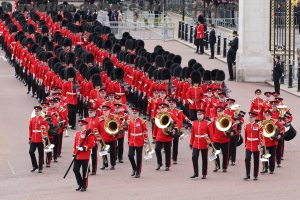
The marching pace for the procession is set at an unnatural 108 paces a minute which is slightly slower than a standard quick march of 116 paces a minute. So even for the ceremonial experts, the Guards in the Household Division, the Coronation Procession is a technical challenge.
The pace will be set by the Gold State Coach. This is four tonnes and slow moving, which means that everything must be timed from the rear of the procession. But Vern claims the advantage is this slightly altered pace will keep the whole parade tighter and more compact.
Vern said: “The biggest challenge is that you have so many regiments represented from the Gurkhas to the Lancers, the Royal Navy to the RAF, and each has its own methods of doing drill with different pacing and so on. We’ve got to create a parade where everyone marches to the same pace, so the timings remain spot on.”
The pace is set with the bass drum and the marches chosen to be played by the Bands throughout the procession all have this regular 108 pace beat. Vern has designed a method of uniting all 19 processional bands to strike up at the same time and maintain the constant beat, whilst playing the same bar, with bands separated by distance over a procession group length of more than a mile.
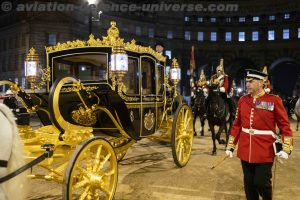
This has enabled a much larger scale of service personnel on the Coronation Procession’s relatively short journey, by compressing the groups, which will make it so visually striking. He has also designed a unique drill manoeuvre to reduce the width of the marching groups from a twelve abreast frontage to six abreast. This will enable the procession, which will fill the entire width of The Mall, to move smoothly through the gates of Buckingham Palace.
Brigade Major Lieutenant Colonel James Shaw has the honour of leading the Coronation Procession from Westminster Abbey to Buckingham Palace. He will be mounted on a horse, Sovereign’s Shadow, at the very front of the procession approximately 1,500 metres in front of the Gold State Coach. He said: “The Army has been supporting Coronations for a thousand years in this country, so we’ve got plenty of precedence. We’re part of that history, it’s very exciting. His Majesty The King is our Colonel-in-Chief, we have a very strong bond. It’s going to be very special for all on parade, and I’m confident we can get it right.”
The British Army is, therefore, ready to play its part in ensuring His Majesty The King’s Coronation is a spectacle to remember.
Courtesy: British Army






































